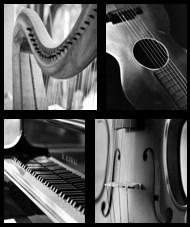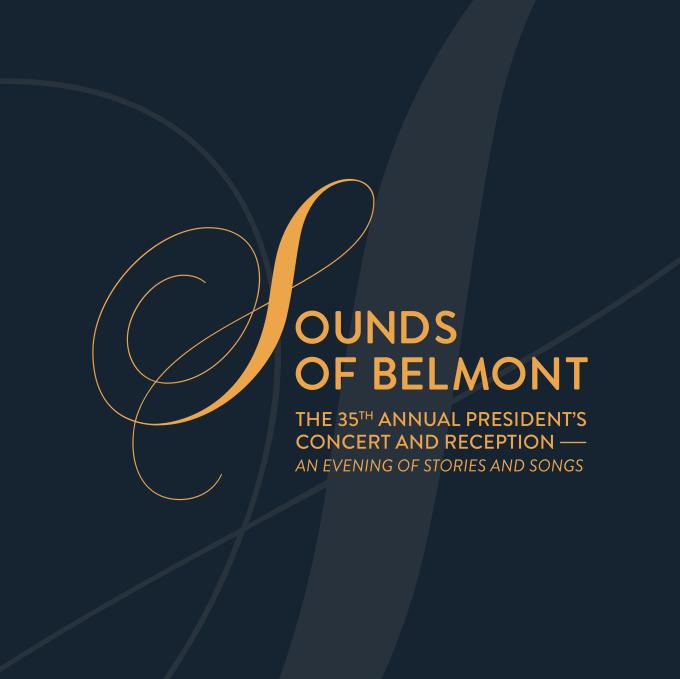

Belmont University School of Music
MONDAY, FEBRUARY 17, 2025
7:30 P.M. MCAFEE CONCERT HALL
Belmont University School of Music
Faculty Concert Series
presents
Harmonies of Hope
Boris Abramov, violin | Carmine Miranda, cello | Ella Tokarska, viola
Goldberg Variations for String Trio, BWV 988
Johann Sebastian Bach
I. Aria (1685-1750)
II. Variation I trans. Dmitry Sitkovetsky
III. Variation II
IV. Variation III Canone all’Unisono
V. Variation IV
VI. Variation V
VII. Variation VI Canone alla Seconda
VIII. Variation VII al Tempo di Giga
IX. Variation VIII
X. Variation IX Canone alla Terza
XI. Variation X Fughetta
XII. Variation XI
XIII. Variation XII Canone alla Quarta
XIV. Variation XIII
XV. Variation XIV
XVI. Variation XV Canone alla Quinta – Andante
XVII. Variation XVI Overture
XVIII. Variation XVII
XIX. Variation XVIII Canone alla Sesta
XX. Variation XIX
XXI. Variation XX
XXII. Variation XXI Canone alla Settima
XXIII. Variation XXII
XXIV. Variation XXIII
XXV. Variation XXIV Canone all’Ottava
XXVI. Variation XXV Adagio
XXVII. Variation XXVI
XXVIII. Variation XXVII Canone alla Nona
XXIX. Variation XXVIII
XXX. Variation XXIX
XXXI. Variation XXX Quodlibet
XXXII. Aria
Boris Abramov, violin
Elzbieta Tokarska, viola Carmine Miranda, cello
Program Notes
The Goldberg Variations, composed by Johann Sebastian Bach, is a seminal work of Baroque music that has captivated audiences for centuries. Published in 1741 as the fourth part of Bach's ClavierÜbung (Keyboard Practice), this majestic composition consists of an aria, which was dedicated to music listeners “for the benefit of their souls” and thirty variations. The work's origins are shrouded in legend, with one account suggesting that it was written as a therapeutic piece for Count Keyserlingk, a Russian diplomat who suffered from insomnia.
The Goldberg Variations is a testament to Bach's unparalleled mastery of counterpoint, harmony, and inventive genius. Throughout the work, Bach employs a dazzling array of techniques, from intricate fugues to lilting dances, to create a rich tapestry of sounds. The variations are woven together by the recurring theme of the aria, which provides a sense of unity and coherence to the entire work. As a result, the Goldberg Variations has become a beloved and revered cornerstone of classical music, celebrated for its technical brilliance, emotional depth, and timeless beauty.
One of the most remarkable aspects of the Goldberg Variations is its ability to balance intellectual rigor with expressive elegance. Bach's ingenious use of mathematical structures and contrapuntal devices creates a sense of awe-inspiring complexity, yet the music remains profoundly humane and accessible. This paradox has made the Goldberg Variations a work of endless fascination for musicians, scholars, and listeners alike, inviting exploration and interpretation from every possible angle.
Glenn Gould's 1955 recording of the Goldberg Variations is widely regarded as a landmark interpretation that revolutionized how people think about Bach's music. Gould's distinctive playing style, characterized by his use of rubato, nuanced pedaling, and contrarian tempos, brought a new level of expressiveness and intensity to the work. His recording also helped to popularize the Goldberg Variations, introducing the piece to a wider audience and cementing its status as a cultural touchstone.
Dmitry Sitkovetsky's string trio transcription of the Goldberg Variations, created in commemoration of Bach's 300th birthday in 1985, stands as a testament to the enduring influence of Glenn Gould's iconic recording. By dedicating this transcription to Gould, Sitkovetsky acknowledged the pianist's profound impact on the work's interpretation and perception.
Sitkovetsky's arrangement is remarkable for its straightforward yet ingenious approach. He takes the original keyboard score and distributes the voicings equally among violin, viola, and cello, creating a trio texture that is both faithful to the original and uniquely suited to the capabilities of string instruments. However, Sitkovetsky's transcription stops short of providing explicit performance instructions, omitting bowings, articulations, fingerings, and dynamics. This deliberate choice turns the transcription into a blank canvas, inviting performers to explore the work's interpretative possibilities.
The resulting arrangement is akin to the Bach Cello Suites in its openness to individual interpretation. Just as cellists have long been accustomed to developing their own distinctive approach to the Suites, string trios performing Sitkovetsky's transcription must engage in a similar process of exploration and discovery. Historical research, technical experimentation, and musical intuition all come into play as performers strive to create a cohesive and compelling interpretation.
The Sitkovetsky transcription has likely inspired many exciting performances and recordings of the Goldberg Variations, each one reflecting the unique perspective and artistic vision of the performers involved. As a tribute to Glenn Gould's legacy, this transcription serves as a reminder of the profound impact that a single musician can have on our understanding and appreciation of a timeless masterpiece.
Program notes by Dr. Carmine Miranda, School of Music Faculty
About the Performers
Boris Abramov: Hailed as “a violinist of outstanding technical accomplishment and exceptional musical talent” (Fanfare Magazine), Boris Abramov has established himself as a versatile artist, performing across the world as a soloist as well as a chamber and orchestral musician. Throughout his career, Abramov has earned numerous awards, including the MTNA Competition in 2008 and a special prize at the 2009 Pablo de Sarasate International Competition. In 2021, he received the Young Alumni Award from Columbus State University.
As a performer, Abramov has appeared as a soloist with numerous orchestras and as a chamber musician around the United States and Europe. He has collaborated with world-renowned artists and participated in prestigious festivals like Killington, Montecito, and Hiuumma. His debut album, Mozart-Beethoven Violin and Cello Duets, with cellist Carmine Miranda, received critical acclaim and won the Silver Medal at the 2017 Global Music Awards. Abramov has served as principal second violinist of the Columbus Symphony Orchestra (2014–2023) and regularly performs with symphonies across the U.S. As an educator, he serves on the violin faculty at Belmont University and conducts seminars and masterclasses worldwide. His students have pursued advanced studies and professional positions in top orchestras and music institutions.
Dr. Ela Tokarska is a highly regarded violinist, violist, and educator with a diverse international career spanning Europe, the U.S., and Asia. She performs regularly as a soloist, chamber musician, and orchestral player across the world. Originally from Poland, Tokarska studied at the Arthur Rubinstein School of Music and the Feliks Nowowiejski Academy of Music, where she earned numerous awards, including top prizes in national and international competitions and scholarships.
In addition to her solo performances, Tokarska regularly collaborates with major orchestras and ensembles, including the Space Coast Symphony, Columbus and LaGrange Symphony Orchestras, and others. As a soloist, she has performed with orchestras in Poland, Italy, and the U.S., and as a chamber musician, she has participated in various concert series and fundraising events worldwide. Tokarska is also an active educator, having taught at LaGrange College, and the University of North Carolina at Greensboro. She has contributed to music education programs in Poland and the U.S. and has worked with young musicians in various outreach initiatives. Tokarska serves as Assistant Professor of Classical Violin and Viola at Belmont University and performs on a violin made by Wojciech Topa in 2016.
Dr. Carmine Miranda has built a distinguished international career, renowned for his captivating performances and impressive technical mastery. He has appeared as a soloist with prominent orchestras, among them including the Caracas Municipal Symphony, Karlovy Vary Symphony Orchestra, and South Czech Philharmonic, and has performed at esteemed concert halls and music festivals worldwide. Carmine's artistic excellence has been recognized through numerous awards and accolades, including top honors in several national and international competitions.
Praised by many publications such as Fanfare Magazine for “fast becoming known for his ability to combine virtuosity with intense, well-thought-out interpretations” and by The Strad Magazine for "showing himself to be in full command of both instrument and works," Miranda's recordings have achieved remarkable success, with several becoming number-one classical bestsellers. His recording of the Dvorak and Schumann Cello Concerti charted in the Billboard Top 50 classical recordings, with over one million Spotify plays. Currently, Carmine serves on the music faculty at Belmont University, where he shares his expertise with cello and chamber music students.
Upcoming Concerts and Events
Jazz Piano Concert Series Kenny Werner Thursday, February 20, 7:30 p.m.
McAfee Concert Hall
Jazz Piano Masterclass Kenny Werner Friday, February 21, 10:00 a.m.
McAfee Concert Hall

Join Belmont University’s College of Music Arts for Sounds of Belmont: The 35th Annual President’s Concert & Reception on Saturday, April 12th in the Fisher Center at Belmont University. Experience an evening of stories and songs to support our talented students. The concert will begin at 6:30 p.m. followed by a festive dessert reception for all guests and performers. The purchase of a ticket to this concert and reception will benefit endowed music and theatre scholarship funds for students in the college. Premier works from the College of Music and Performing Arts Fall 2024-Spring 2025 performance season will be showcased. This concert and reception is celebrating its thirty-fifth year (formerly the President’s Concert and Reception).
For more information on upcoming concerts and events, please visit www.belmont.edu/cmpa or “like” Belmont University School of Music on Facebook.

